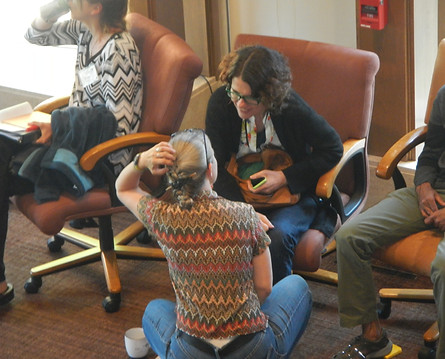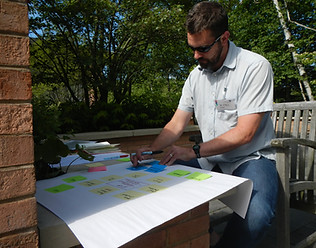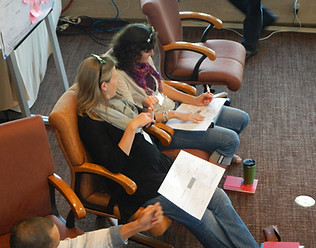
Program Design
The Earth Leadership Program prepared researchers to work together as effective agents of change by providing tools and perspectives to help participants cross traditional disciplinary and sector boundaries. Collaborating with other researchers and with networks of stakeholders is critical to address complex sustainability challenges.
The fellowship training model was built around a collaborative approach that values co-design with diverse stakeholders and prepares participants to develop and execute transdisciplinary projects. The training thus introduced tools that enabled groups to self-organize and transform systems in a networked way, rather than simply improving personal skills or preparing faculty to become higher education administrators.

What was the training experience?
Over the years, the Leopold Leadership Program developed and refined a thoughtful process for drawing out a new kind of leader. The Earth Leadership Program continued this process.
1
Self-select
The first step was allowing the right people to sign up. Rather than ask senior faculty to nominate rising stars, we preferred to let the right people step forward. Pursuing committed, transdisciplinary work isn’t for everyone. It takes a person who is motivated to go beyond their normal service duties to make change because they believe it’s right and necessary. Earth Leadership fellows are leading academics willing to step out of their comfort zones to contribute to the common good.
3
Reflect
Personal change takes time. It’s hard to form new habits and mindsets. The Earth Leadership Program provided opportunities for participants to envision their own futures as well as the futures they want to see. We provided time for discussions with colleagues, listening walks, and journal writing. Whatever your idiosyncratic method of synthesizing ideas may be, we made space for it.
2
Retreat
We have found that the best outcomes happen when fellows are able to get away from the demands of job, family, and friends. Equally important, we were committed to creating safe, low-risk retreat environments so that fellows could acquire new skills without fear. Our experience shows that providing the time and space to practice new skills, with peers, in a supportive environment, increases the odds that the skills fellows learned would be used long past the training.
4
Practice
After intensive work, our fellows went back to their respective universities. We sent them home with practical tools: A personal development plan, a network of 200+ fellows to contact with questions, specific goals and timelines, and small support groups to mastermind problems as they arise.

The program addressed a series of leadership questions and built on fellows’ individual experiences and competencies. The learning was both facilitated and self-directed, and as concepts, tools, and strategies were presented, participants had time to practice and get feedback. Fellows were engaged from morning to evening, balancing the day between highly interactive sessions and reflective activities such as journal writing or one-on-one debriefing conversations. Time was set aside at the end of each afternoon for fellows to take a walk or run, challenge one another to a pick-up game of basketball or croquet, or take part in other unstructured activities. Evening sessions provided time for further exchange and sometimes included case studies from alumni fellows and other invited guests.
In the year between their training sessions, fellows practiced new skills at their home institutions or in other venues to apply what they learned. Activities included:
-
Interviewing for information to fill gaps in their network
-
Incorporating what they’ve learned into their work teaching and mentoring students and postdocs
-
Expanding their skills in facilitating interdisciplinary groups.


Fellows are on the leading edge of developing the practices that are needed for complex problem-solving and they were critical resources to each other. As a network, the fellows provided powerful ongoing support to one another. During the practice year they organized periodic check-ins in pairs or small groups to remind themselves of the short- and long-term goals they set for themselves in their action plans. Fellows were expected to manage their time in order to engage fully in learning from their practice.
The following June, the fellows reconvened in a final session to integrate their learning from the practice year, learn new tools, and articulate to each other their refined visions for knowledge to impact. This experience enabled fellows to decide where, when, and how to engage for the greatest impact in furthering their vision for change.


After their fellowship year, fellows were expected to:
-
Build on what they learned to create a positive impact on decision-making about the environment and sustainability
-
Share with their graduate students the skills learned in the course of the fellowship and mentor students and others in their development as leaders
-
Contribute to the sustainability of the Earth Leadership Program by providing ongoing feedback, sharing best practices, and serving as coaches and mentors to other fellows
Leadership context: Areas of focus
For lasting change, we need a new type of leader, one who uses a collaborative model to co-create solutions with others. We need leaders who listen, and who commit to endeavors for the long haul. Our model flies in the face of the traditional Western hero. Our leaders are not lone rangers, cowboys, or solitary geniuses. They are team players who use scientific and emotional intelligence to bring society together. This brand of leadership might not look flashy, because it isn’t. But with grit, practice, and patience, it works.
What it means to be a scientist now is different than it was 30 years ago. Back then astronauts weren’t sharing views of space over social media and ecologists generally kept to their data. But in the same way that scientists have learned to speak with the media directly about their research—and universities have integrated communications classes into science departments—new times call for new roles.
More than ever, scientists are being called to step into leadership roles to solve the environmental crises that matter in each community. We have the credibility and knowledge to make a difference–but we need nuanced leadership skills to ensure that our voice has influence. We concentrated on three broad areas in our collective leadership training:

Individual leadership
development
Deepening awareness of leadership style, identifying areas for growth and development, and creating sustaining practices
-
Assess personal leadership type and qualities
-
Articulate a vision of what matters; identify and clarify purpose
-
Gain confidence by articulating a leadership plan with a set of practices

Facilitating collaboration
and networking
Building capacity to engage a group of people, enabling them to think together
-
Learn frameworks and models for effective working group collaboration and dialogue
-
Interview for information to fill gaps in their network to fulfill their vision for change
-
Build capacity for working effectively with stakeholder partners, graduate students and colleagues
-
Experience an on-going support group where each individual feels safe to try and share learning

Understanding systems
Making an impact by inspiring innovative, creative, collaborative transdisciplinary research projects
-
Diagnose and design four layers of a system: action, structure, tone, and identity
-
Learn systems thinking tools: actor and trend mapping
-
Apply systems design framework to a specific sustainability challenge
Collective leadership framework
The Earth Leadership Program embraced a leadership model that encouraged individuals to cross boundaries and work collaboratively to transform systems. This collective leadership model is well-suited to academic researchers who rely on broad networks to advance sustainability.
Fellows honeD a unique set of competencies that allowed them to become agents of change. First, they recognized their own strengths and weaknesses, and then developed strategies for reaching out to others. Through this relational framework, they gained insights on how best to create alignment among those involved and how to build—and sustain—momentum on a project. The key leadership dimensions that were integrated into our programs are:
Assess challenges and strengths
Gather multiple perspectives
Understand context and networks
Create alignment on shared goals and directions
Develop credible, relevant solutions
Inspire ongoing action
Bringing training to universities and networks
In light of the need to meet growing demand, we also worked with teams or networks of researchers within the same university. We began this work in 2010 when Jon Foley, the former director of the Institute for the Environment at University of Minnesota invited us to design and facilitate a program for their fellows. That partnership continued when Jessica Hellman offered to co-host the Leadership Teach-In in May 2017, where teams from universities had the opportunity to learn from one another about program design and by participating in train-the-trainer skill sessions.
We continued to work with universities at multiple levels, from graduate students to mid-career faculty programs, by advising in planning sessions and/or by providing on-site training and follow-up. Our approach was best described as a train-the-trainer model in order to expand the in-house capacity of universities.
We also participated in resource exchange networks so that we could contribute to our resource portal and similar platforms of other networks. You will find how-to guides on multiple topics, written by fellows and sustainability leadership facilitators and trainers. We hope that this approach will build the field of transdisciplinary researchers.





